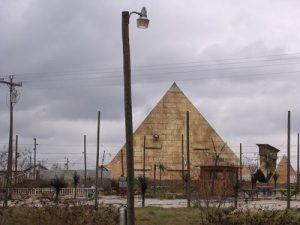Throughout their lengthy and complex history, it should be noted that–along with their efforts at separatism as an extension of their black nationalism–Afrocentricity remains one of the core tenets of the Nuwaubian Nation, regardless of other doctrinal, iconographic or locational changes. Palmer makes the astute observation that, while not everyone involved or familiar with the Nuwaubians specifically adhered to the entirety of the doctrine or practice set out by the group, they often “expressed a romantic interest in their African heritage and wished to communicate ‘Black Pride’ to their kids.”1 As such, understanding Afrocentricity–and its progeny Afrofuturism–as a significant aspect of the Nuwaubian ideology proves valuable as it is the lens through which the Nuwaubians often distilled their other beliefs and practices.

In the same vein as forebearer Marcus Garvey, York–and the Nuwaubians as consequence–were undoubtedly influenced by both Afrocentricism and Pan-Africanism. In every layer of the Nuwaubian doctrine and practice, there is a challenging, critiquing and rejection of “the academic curricular, paradigm, and pedagogical methods at all levels bemoaning the focus on European culture.”2 The focus on Afrocentricism in Nuwaubian culture and belief is significant on two fronts. Primarily, it acts as a methodology for the relationship built between the social and the spiritual to come to fruition. As Afrocentrism constitutes an
Africa-centered paradigm, [which acts] as an alternative to Eurocentrism, essentially, [and] maintains the right of African descendants to an alternate knowledge system that serves the specific intellectual needs of Africans at home and in diaspora.3
This “alternate knowledge system” is the framework through which the Nuwaubians distilled both their social and spiritual liberation. By using Afrocentricity as a core tenet of the movement, it allowed the group to navigate other periphery aspects of its belief system and structure more systematically. For example, influencing religious traditions from Christianity or Judaism, within the system of Afrocentricity, do not constitute random borrowings or supplementary religious ideas, but rather function within the Nuwaubian’s larger framework of readapting beliefs to center them on Africa, rather than the typical Eurocentric lens that these religious often operate within.
Further, Afrocentricity guides the Nuwaubians’ belief system forward, as their incorporation of Afrofuturism required Afrocentricity as a preceding framework for Afrofuturism to develop out of. This development saw the Nuwaubians “embracing more mythological thoughts and belief in alien invasion,”4 suggesting that “[h]aving unsuccessfully sought acceptance within mainstream religions, Nuwaubians severed the ties ideologically by toeing an increasingly non denominational line and becoming unaligned with any religion whilst maintaining a reverence for Africa.”5 Thus, Afrocentricity acts not only as a core element through which Nuwaubians interacting with other beliefs, but it also provided the guidelines that the movement followed as they increasingly moved away from more traditional or mainstream religious movements.
1 Susan Palmer, The Nuwaubian Nation: Black Spirituality and State Control (Farnham, Ashgate Publishing Limited, 2010), xxxiv.
2 Emeka C. Anaedozie, Post Civil Rights Black Nationalism: The Nuwaubian Nation of Moors’ Model 1967-2002, (Morgan State University, 2013), 9.
3 Ibid.
4 Ibid., 107
5 Ibid.
Photography:
Amber Rhea. “The Weekend in Review.” Neon Poisoning, http://photos1.blogger.com/blogger/3381/296/1600/DSCN1312.sized.jpg (accessed November 8, 2018).